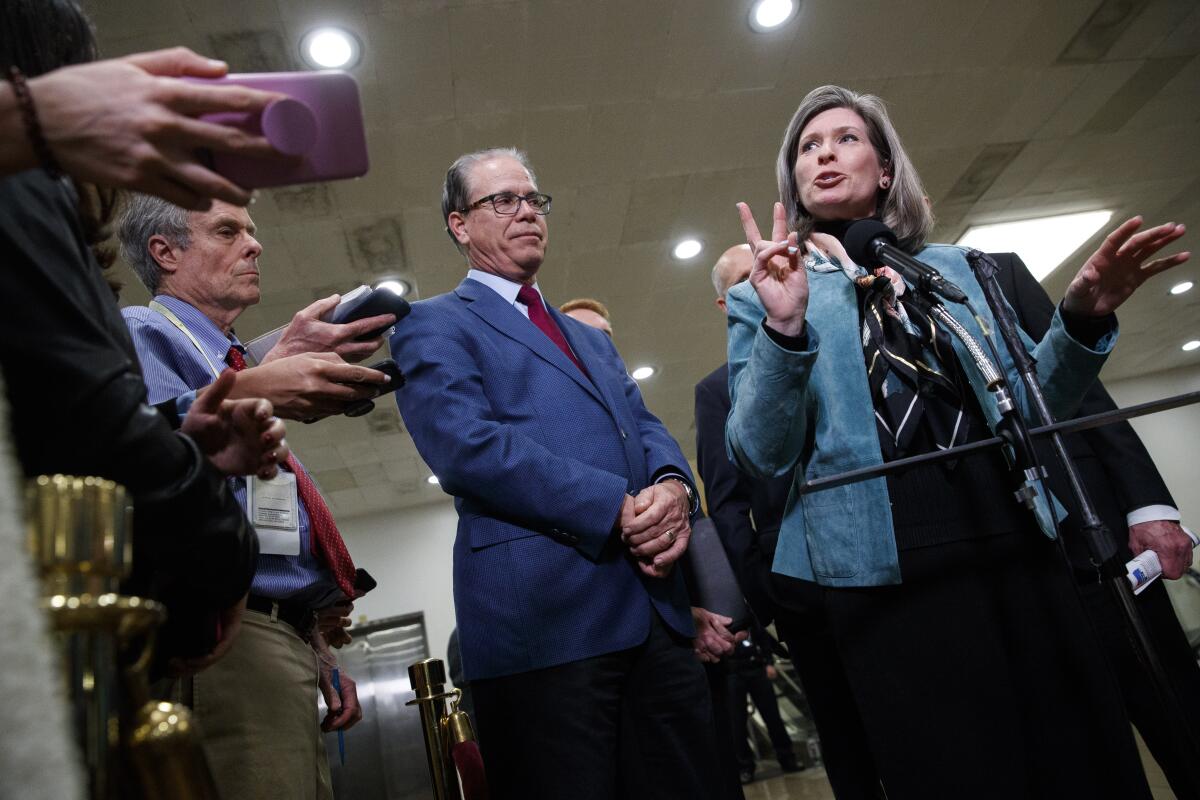GOP increasingly worried about losing Senate control

WASHINGTON — Iowa Sen. Joni Ernst won her Senate seat and Republican Party stardom six years ago on a promise to go to Washington and “make ’em squeal,” just like the pigs she castrated on her family farm growing up.
If anyone’s squealing this year, it is Ernst and other Senate Republicans who are locked in neck-and-neck races against Democratic challengers in an unusually large number of states.
In places like Iowa, Arizona, North Carolina, Georgia and Maine, Republicans are left hoping President Trump will defy the polls to win, carrying them along with him. Otherwise they’ll need to capture enough of those rare voters who split their ballot to support Democrat Joe Biden for president and a Senate Republican.
Against those odds, Republicans are likely to lose control of the Senate next year, according to many political forecasters and polls. To seize the majority, Democrats would have to pick up three seats, or four if Trump is reelected.
Given how closely divided the Senate is, a 50-50 split is possible. And if Biden wins, Democrats could rely on a Vice President Kamala Harris to break any Senate ties.
But a Senate tie would almost certainly fuel deadlock, because Democrats would not be able to afford to lose even a single vote from their caucus.
The fate of Senate contests has grown increasingly reliant on the outcome of the presidential race over the last several presidential election years. In 2016, they fell into perfect alignment: Where Trump won, so did the Republican candidate; and the same with Hillary Clinton and Democrats. So far in 2020, polls suggest that trend could continue.
Senate Republicans “may be outperforming Trump in some of these places, but given the state of the polls, the match rate could very well be what causes Republicans to lose the Senate,” said Kevin Madden, a longtime Republican advisor to presidential and congressional candidates.
In this starkly polarized environment, there is no upside for Senate Republicans to try to distance themselves from Trump now. They would risk losing the support of Trump’s die-hard base in order to scoop up the few remaining undecided independents. And those independents can be fickle and unreliable voters, particularly compared with Trump loyalists.
Republicans who “are in competitive races realize that their fortunes are largely tied to the performance of the president,” said Sen. John Thune (R-S.D.), the No. 2 Republican in the chamber. “That doesn’t mean they can’t win without him, but it certainly means their chances of winning are enhanced if he performs well.”
Trump doesn’t seem to see the correlation.
“I probably help some. I don’t think I hurt anybody. But I don’t view them as being tied together, I never did,” Trump said recently in Arizona, where Sen. Martha McSally is one of the most vulnerable Republican incumbents. “I could do fantastically well in this state and we could have a Senate candidate that does unbelievably badly.”
In both Arizona and North Carolina, the Senate Republican incumbent is trailing Trump in the polls, meaning they would need the president to win by a handful of points in order to get any boost from his coattails, according to a Republican working on Senate races.
Democrats are widely expected to lose a seat in Alabama but pick one up in Colorado. They are favored to capture GOP-held seats in Arizona and to a smaller extent in Maine. Iowa and North Carolina are toss-ups. Further out of reach for Democrats are GOP strongholds like South Carolina, Montana, Kansas and Texas, which had appeared in polls to be slipping away from Republicans, but now party officials feel they have pulled them back. Two Republican-held seats in Georgia could go to runoffs if no candidate gets 50% of the vote next week.
For Republicans to have a path to keep the Senate, they would probably have to take Democratic-held seats in Michigan and Minnesota. While polls have tightened in both states, Democrats still have a lead outside the margin of error. The best Republicans can hope for is probably a 51-49 Senate, according to GOP officials.
The toss-up in Iowa has turned that race into one of the most expensive in the country. Whereas Ernst won by more than 8 percentage points in 2014 and Trump defeated Clinton by more than 9 just two years later, Trump’s drag has made it a toss-up, strategists say.
“Certainly, Trump is running a much closer election in Iowa than in 2016,” said a Republican official working on the race. “To the extent the partisanship in Iowa has narrowed in this cycle, it probably contributes to the fact that it’s a tighter race than we had in ’14, which was a wave Republican year.”
The farmgirl, mom and combat military veteran won her seat in 2014 with a folksy conservativism that appealed to the GOP establishment as well as the tea party conservatives who had come to dominate the party four years earlier. In her first year in the Senate, she was given the high-profile assignment of delivering the Republican response to President Obama’s State of the Union speech, and quickly became a member of Republican leadership.
In hopes of a second term, Ernst’s camp is touting her work on ethanol — important to Iowa farmers — as well as her work on veterans issues and the USMCA, Trump’s trade deal.
Republican strategists involved in the race but granted anonymity to speak freely cast blame on the more than $100 million they say Democrats have poured into the state to muddy Ernst’s record — they were on air early in 2020 — and boost her Democratic opponent, Theresa Greenfield.
The campaign ads say Ernst went to Washington, lost her Iowa roots and never made ’em squeal — a message that has resonated with some voters.
Toni Sumpter, a 60-year-old retired pharmacist who lives in a suburb of Des Moines, said she has “no major complaints” with Ernst, but Greenfield’s interest in strengthening Social Security and preserving Obamacare earned her support. A traditionally but not exclusively Democratic voter who has already cast a ballot for Biden and Greenfield, Sumpter doesn’t see any value in splitting her vote.
“It’s important to me to have the Senate controlled by the Democratic Party. That’s the only way you get anything done,” she said.
As Republicans’ fortunes have fallen among suburban women — in Iowa as in the rest of the country — they have risen in rural areas. In fact, Republican Gov. Kim Reynolds in 2018 gained on Ernst’s margin in the most rural parts of the state in 2014, suggesting that Ernst could make up for the suburban losses in Iowa’s expansive rural areas.
Greenfield’s path lies in massive turnout in the urban and suburban parts of the state, and in convincing voters who backed Obama but flipped to Trump to come back to Democrats. Ernst’s camp says that Greenfield would be beholden to the liberal agenda of Senate Minority Leader Charles E. Schumer (D-N.Y.), such as the Green New Deal and “Medicare for all.” Greenfield says she opposes those policies.
With Nov. 3 closing in, some Republicans have quietly taken up the argument that with Biden surging in the polls, Republicans should hold on to the Senate in order to keep a check on the Democratic House and White House.
The National Republican Senatorial Committee, the group that boosts Senate Republican candidates, has run an ad in Iowa questioning that possibility.
“What happens if they have all the power?” the ad says, with a picture of Speaker Nancy Pelosi (D-San Francisco), Schumer and Biden. “Stop the liberal nightmare.”
A similar ad has run in Montana. In Maine, Sen. Susan Collins is touting her importance to the state “no matter who you’re voting for for president.”
Senate Majority Leader Mitch McConnell (R-Ky.) argued Friday that a GOP-led Senate would serve as a better check on a Biden administration. “The solution to this is 51 Republican senators,” he said on the Hugh Hewitt show.
Times staff writer Noah Bierman in Washington contributed to this report.
More to Read
Get the L.A. Times Politics newsletter
Deeply reported insights into legislation, politics and policy from Sacramento, Washington and beyond. In your inbox three times per week.
You may occasionally receive promotional content from the Los Angeles Times.











